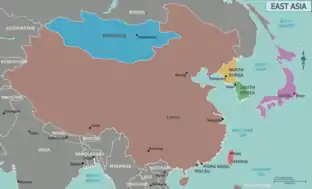Northeast Asia
Northeast Asia or Northeastern Asia is a geographical subregion of Asia; its northeastern landmass and islands are bounded by the Pacific Ocean.


The term Northeast Asia was popularized during the 1930s by American historian and political scientist Robert Kerner. Under Kerner's definition, "Northeast Asia" included the Mongolian Plateau, the Northeast China Plain, the Korean Peninsula and the mountainous regions of the Russian Far East, stretching from the Lena River in the west to the Pacific Ocean in the east.[1]
Definitions
The definition of Northeast Asia is not static but often changes according to the context in which it is discussed.
In common usage, the term Northeast Asia typically refers to a region which includes Northern China.[2][3] Core countries constituting Northeast Asia can be said to be Russia, Mongolia, Japan, North Korea, South Korea and China. Taiwan may also be included in some definitions.[4] As well, the World Bank acknowledges the roles of sub-national or de facto states, such as Hong Kong and Macau.
The Economic Research Institute for Northeast Asia defines the region as Russia, Mongolia, Japan, Korea and China.[5]
The Yellow Sea, the Sea of Okhotsk, and the East China Sea are also included in discussions of the region.
Economics

Northeast Asia is one of the most important economic regions of the world that constituted 25.3% of the world's nominal GDP in 2019 which is slightly larger than the United States. It is also one of the major political centers and has significant influence on international affairs. By the end of the 1990s, Northeast Asia had a share of 12% of the global energy consumption, with a strong increasing trend. By 2030, the strong economic growth in the region is expected to double or triple this share.
Biogeography
In biogeography, Northeast Asia generally refers to roughly the area spanning Japan, the Korean Peninsula, Northeast China, and the Russian Far East between Lake Baikal in Central Siberia and the Pacific Ocean.
Northeast Asia is mainly covered by temperate forest, taiga, and the Eurasian steppe. In the region's far North, there is also tundra. There is a vast contrast with temperatures between summer and winter. It is also a mountainous area.
See also
References
Citations
- Narangoa 2014, p. 2.
- "Northeast Asia dominates patent filing growth." Retrieved on August 8, 2001.
- "Paper: Economic Integration in Northeast Asia." Retrieved on August 8, 2011.
- Gilbet Rozman (2004), Northeast asia's stunted regionalism: bilateral distrust in the shadow of globalization. Cambridge University Press, pp. 3-4
- Economic Research Institute for Northeast Asia (1999). Japan and Russia in Northeast Asia: Partners in the 21st Century. Greenwood Publishing Group. p. 248.
Sources
- Narangoa, Li (2014). Historical Atlas of Northeast Asia, 1590-2010: Korea, Manchuria, Mongolia, Eastern Siberia. New York: Columbia University Press. ISBN 9780231160704.CS1 maint: ref=harv (link)
External links
- Center for Northeast Asian Policy Studies - Brookings Institution
- Kimura, Takeatsu - International Collation of Traditional and Folk Medicine - Northeast Asia - UNESCO